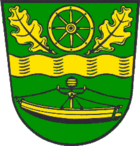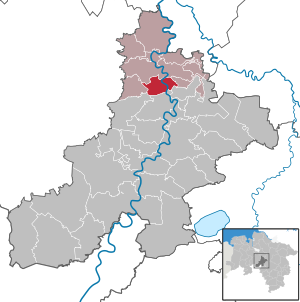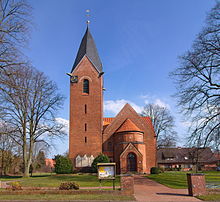Schweringen
| coat of arms | Germany map | |
|---|---|---|

|
Coordinates: 52 ° 45 ' N , 9 ° 11' E |
|
| Basic data | ||
| State : | Lower Saxony | |
| County : | Nienburg / Weser | |
| Joint municipality : | County Hoya | |
| Height : | 20 m above sea level NHN | |
| Area : | 19.52 km 2 | |
| Residents: | 788 (Dec. 31, 2019) | |
| Population density : | 40 inhabitants per km 2 | |
| Postcodes : | 27333, 27324 | |
| Area code : | 04257 | |
| License plate : | NI | |
| Community key : | 03 2 56 028 | |
| LOCODE : | DE SRI | |
| Community structure: | 3 districts | |
| Association administration address: | Schloßplatz 2 27318 Hoya |
|
| Website : | ||
| Mayor : | Bernd Meyer (WGWFS) | |
| Location of the municipality of Schweringen in the Nienburg / Weser district | ||
Schweringen ( Swering in Low German ) is a municipality in the municipality of Grafschaft Hoya in the district of Nienburg / Weser in Lower Saxony .
geography
The municipality of Schweringen is divided into the villages of Schweringen, Eiße and Holtrup.
history
Schweringen was first mentioned in 1139 in a document from the St. Pauli monastery outside Bremen . This monastery owned lands in Holtrup and Schweringen. Holtrup (Holthrope) and Schweringen (Sveringe) are mentioned as early settlements in the Weser valley with sandy geest and fertile marshes . Construction of the church began in 1914. In the First World War he rested. The consecration took place in 1922. The old chapel was demolished in 1958.
On March 1, 1974, the neighboring community of Holtrup was incorporated.
- Population development
| year | 1961 | 1970 | 1987 | 1992 | 1997 | 2002 | 2007 | 2008 | 2009 | 2010 | 2011 |
|---|---|---|---|---|---|---|---|---|---|---|---|
| Residents | 991 | 971 | 755 | 818 | 849 | 861 | 846 | 848 | 846 | 805 | 792 |
(1961: June 6th, 1970: May 27th, each time with Holtrup, from 1987 on each December 31st)

|
politics
Municipal council
The nine seats of the municipal council are distributed as follows:
- Voting community "We for Schweringen" 4 seats
- Flat share 4 seats
- GREEN 1 seat
(Status: local election on September 11, 2016)
coat of arms
A golden wave bar in green ; above a golden wagon wheel , accompanied on both sides by a golden oak leaf , below a golden ferry bay with a masthead light .
For the municipality of Schweringen, the Weser is the geographical center of the municipality on both sides of the Weser. The wave bar is therefore symbolic of the Weser as a coat of arms. The ferry, a centuries-old, documented crossing of the Weser and still in operation today, is another coat of arms symbol. Shown as a coat of arms is not the actual carriage ferry, but a boat called "Fährbuchtnachen" in technical terms. The wagon wheel should refer to the main line of business of the municipality, namely agriculture. In addition, the wheel should symbolize craft, trade, trade and traffic.
Culture and sights
A total of seven large-scale works of art by the Schweringen artist Gottlieb Pot d'Or (1905–1978) can be found in publicly accessible buildings in Schweringen . They date from the period after the Second World War to 1977:
- Fired clay pictures on the outer facade of the Schweringen youth home (mid-1950s)
- two large frescoes in the interior of the youth home (mid-1950s)
- Resurrection of Christ (1968) is a large-scale mosaic made of ceramic tiles for the Schweringen cemetery chapel. It replaced a mural painted in the 1930s
- a large wall piece in the Volksbank Schweringen. The abstract-figurative composition dates from the 1970s
- a mosaic made of Weser pebbles on the facade of the gym in Schweringen from 1977
- a picture of the post-war period in the Schweringen church
"Altarpiece, which is constructed in the form of a triptych and in an expressionistic-realistic manner the crucifixion of Christ against the background of the roaring and chaotic war and world events as an impressive testimony to human suffering"
NS bell in the Schweringen church
In September 2017 it became known that in the bell tower of the Schweringen church there was a bell with a 30 cm swastika and the inscription “Germany awoke from need and from night, this cross gave success helped overcome discord Thank you God”. The bell was hung in the tower in 1934. After the end of the Nazi regime , the bell was quietly left there.
The local church council then stopped the bell until further notice. After controversial discussions, the church council decided in March 2018 to reuse the bell with the National Socialist symbol and text despite an offer from the regional church of Hanover to cover the costs for a replacement.
On March 29, 2018, the pastor discovered that strangers had removed the swastika and part of the inscription “this cross gave success helped overcome discord” from the bell. In a letter of confession with the headline “Spring cleaning 2018”, it was said that “you don't just want to watch the village run towards a split. That is why facts were created ”. The bell, which has become unusable as a result, should be removed. The bell was dismantled in November 2018. The bell is to be rededicated at Whitsun 2020.
Economy and Infrastructure
The place has the last Weser ferry in the entire Middle Weser area. It connects the place with the eastern bank of the Weser. There are over 300 hectares of fertile pasture and arable land that belongs to the Schweringen district. The backwater ("Alte Weser") near the ferry port , Gandesbergen , suggests that in earlier times the river ran further east and that the Schweringen was separated from its areas by a changing course of the Weser, which they then reached by ferry.
The ferry, built in 1948 with a load capacity of 13.8 t, was a yaw ferry guided on a longitudinal rope . It was replaced in 1999 by a high- wire ferry with a chain drive, lifting capacity 45 t, built at the Hermann Barthel shipyard in Derben / Elbe .
Personalities
- Gottlieb Pot d'Or (* 1905 in Bremen ; † 1978 in Schweringen), painter and graphic artist , lived and worked in Schweringen from 1932 until his death. Numerous murals and large-scale mosaics in and on public buildings (schools, churches, cemetery chapels, savings banks and banks) in Schweringen and the surrounding area come from him and are reminiscent of him.
- Helga Nordhausen (* 1929, † 2012), author who wrote mainly in Low German , lived in the district of Eiße
- Tomas Cramer (* 1967), author of detective novels, youth and non-fiction books, has lived in Schweringen since 1991
literature
- Ortschronik Schweringen. Schweringen 1987
- Cornelia Heising: From Bremen to Nienburg. In the footsteps of the painter Gottlieb Pot d'Or. In: Wendula Dahle (ed.): In the land of moors and dykes. Excursions left and right of the Weser. A travel and reading book. Bremen 1998 (352 pp.), Pp. 181-189; ISBN 3-86108-466-X
- Cornelia Heising: Pot d'Or. (Ed .: KulturKontor), Bremen 1995, 24 p. M. numerous Fig.
- Friedrich Wilhelm Brandt: Schweringen ferry. The last floating bridge on the Middle Weser. (Publications of the "Arbeitsgemeinschaft inland ferries in Germany", Volume 2), Bremerhaven 1999, 40 p. M. 20 fig.
- Tomas Cramer : Schweringen impressions. ISBN 978-3-7375-1718-8 , epubli Berlin 2014, edition northwest.
Web links
Individual evidence
- ↑ State Office for Statistics Lower Saxony, LSN-Online regional database, Table 12411: Update of the population, as of December 31, 2019 ( help ).
- ↑ For a long time the old village had to be content with a chapel
- ↑ a b Federal Statistical Office (ed.): Historical municipality register for the Federal Republic of Germany. Name, border and key number changes in municipalities, counties and administrative districts from May 27, 1970 to December 31, 1982 . W. Kohlhammer GmbH, Stuttgart / Mainz 1983, ISBN 3-17-003263-1 , p. 191 .
- ↑ LSKN-Online
- ↑ http://wahlen.kdo.de/content.php?kunde=sg_grafschaft_hoya&wahlverz=sg_grafschaft_hoya/web/201609_K__Gemeinderatswahl_Schweringen_11.09.2016&wahlname=Gemeinderatswahl_Schweringen_11.09.2016&atei=160524142515484_0_1_t.html .xt_0_1_t.html .xt_1_t.html
- ↑ https://wahlen.kdo.de/content.php?kunde=sg_grafschaft_hoya&wahlverz=sg_grafschaft_hoya/web/201609_K__Gemeinderatswahl_Schweringen_11.09.2016&wahlname=Gemeinderatswahl_Schweringen_11.09.2016&atei=160524142515484_0_1_txt_160524142515484_0_1_txt
- ↑ Two Nazi bells discovered in Lower Saxony. In: NDR.de. September 18, 2017, accessed March 15, 2018 .
- ↑ Jann-Axel Hellwege: The three faces of the bell. Community letter Balge-Schweringen, March 2018.
- ↑ Matthias Brosch: The Nazi bell no longer rings. In: The Rake . 18th September 2017.
- ↑ Michael Wendt: Bell with swastika: Schweringen is split. In: Kreiszeitung.de . 23rd November 2017.
- ^ Matthias Brosch: Regional Church offers help. Interview with the vice-president of the regional church office de Vries, Die Harke, March 13, 2018.
- ↑ Matthias Brosch: "Fatherland Bell" should ring again. In: The Rake . 15th March 2018.
- ↑ Swastika flexed from a bell. In: DieHarke.de. April 3, 2018, accessed April 3, 2018 .
- ↑ Manon Garms: Unknown people have flexed the swastika from the Schweringer bell. In: DieHarke.de. April 2, 2018, accessed April 3, 2018 .
- ↑ Unknown flexing swastika from church bell. In: HAZ.de (Hannoversche Allgemeine). April 3, 2018, accessed April 3, 2018 .
- ^ Church: Damaged Nazi bell in Schweringen is taken down
- ↑ The Nazi bell in Schweringen is decommissioned. Süddeutsche Zeitung , November 20, 2018, accessed on August 10, 2020 .
- ↑ The earlier Nazi bell is inaugurated after the redesign
- Jump up ↑ Christian. The last ferry on the Mittelweser runs between Schweringen and Gandesbergen. on weser-kurier.de from September 11, 2012








